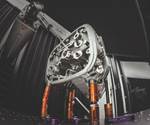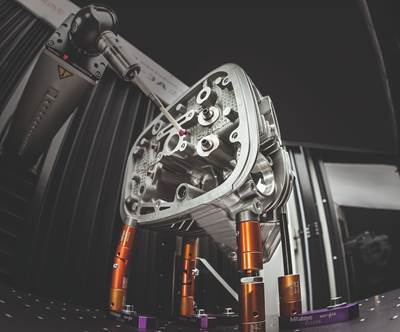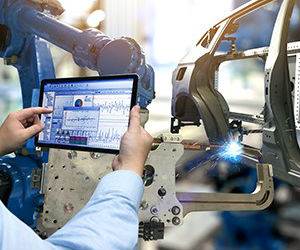Getting More with Digital Indicators
Today’s digital indicators are not only replacing dial indicators in some instances, but they are also approaching the performance of bench amplifiers at a fraction of the cost.
The first practical digital indictors were introduced to the manufacturing world in the 1980s. These early models were basic: One might have read a comparative value, switched for inch/metric and maybe changed polarity. It seemed that these revolutionary new devices would make dial indicators obsolete within a few years.
Well, dial indicators are still here and may never go away in some form, but vast improvements have been made to digital indicators. They are not only replacing dial indicators but also approaching the performance of bench amplifiers at a fraction of the cost. Today’s digital indicators are smaller, more portable and better able to withstand the rigors of a production environment. Options are available that cost only slightly more than a good dial indicator, and other options cost a fraction of the price of a bench amplifier and probe.
Here are some of the features that can be found in typical digital indicators today.
First, digital indicators incorporate a range of dynamic measurement capabilities that used to be available only in higher-end devices. These include minimum, maximum and total indicated reading (TIR) functions. The indicator “remembers” the highest and lowest points measured on a part, and either displays both or subtracts the minimum from the maximum to calculate TIR. These are useful when gaging round parts in a V-block fixture, for example, or measuring the height of a flat surface. The operator can quickly turn a shaft through a complete revolution or move a flat part around under the gage head without pausing to read the display. When workpiece manipulation is complete, the operator can select to display the maximum/minimum ID, OD, height, depth or runout.
Other advanced functions can speed gaging setups. The auto-zero function, for example, is the electronic equivalent of the rotating bezel on mechanical dial indicators: The operator brings the gage head into rough contact with the master and simply zeroes the amplifier, eliminating the need for ultra-careful positioning of the gage head. Additionally, many digital indicators now have a reference value that is built into the scale, which allows the indicator to shut off. Once turned on, it will still remember its most recent re-zeroing position.
A master deviation function also enables compensation of the master error as part of the zeroing (mastering) routine. For example, if a spec calls for a nominal dimension of 1.99980 inches, but you've only got gage blocks handy for 2.00000 inches, this isn’t a problem. Simply set the zero at 2.00000 inches, master the gage and program in a deviation of +0.00020 inch to all measurements. This provides quick and easy mastering without the hassle of post-measurement arithmetic. This is also a potential money saver in masters since it enables the purchase of a lower-grade master. If the master is certified by a quality calibration facility, the use of the master deviation really improves the performance of the measurement process.
A preset value allows for switching between comparative and absolute measurements. In other words, instead of gaging deviation from nominal, the indicator displays actual part dimensions. In the above example, if a part was 0.00010 inch above nominal, the display would read 1.99990 inches.
Digital indicators allow users to establish tolerance limits, and some incorporate limits or signals to indicate in-tolerance and out-of-tolerance conditions. With features such as this, the user doesn’t have to read the measured value, but rather just look at the tolerance symbol.
When the first digital indicators were introduced, the manufacturing world was starting to learn how to use measured data on the shop floor for qualifying parts, documenting results or preventing bad parts from being made. Not only is data output pretty much standard on most digital indicators today, some even feature wireless transmitters so the operator can collect data for part measurements without cluttering his or her workbench. This makes data collection easier and virtually transparent for the user. These days, it is also very common for digital output to be used for data collection and SPC. However, gaging data from digital indicators can also be used to control production machinery on an in-process basis, replacing expensive dedicated closed-loop controllers at a fraction of the cost.
One of the strong points that bench amplifiers had over the digital indicators was accuracy and resolution. Getting to submicron measurements has always required a full-feature bench amplifier. But again, technology is giving this capability to digital indicators. There are now high-resolution digital indicators with submicron resolution and performance, providing ranges that can outperform a bench amplifier.
However, there is still one thing that today's digital indicators cannot do quite as well as a bench amplifier: combining two or more readings for a result. But even this can be worked around. Signal sharing can be accomplished by taking the data output signal of each digital indicator and sending it to a computer to be combined in a low-cost method such as Excel or other SQC type programs. A few indicators and a very basic PC are apt to cost significantly less than a dedicated multi-input bench amplifier.
Not all digital indicators incorporate the features listed here, although many do include these features as well as multipliers, equations and more. If you are still using an electronic amplifier, you may want to compare the features of several digital indicators to see if they can make your gaging more efficient and productive. Digital indicators may not be the end-all replacement for the large display and high resolution of a powerful bench amplifier, but with all of the capabilities currently available, it's certainly worth a look.
Related Content
Ballbar Testing Benefits Low-Volume Manufacturing
Thanks to ballbar testing with a Renishaw QC20-W, the Autodesk Technology Centers now have more confidence in their machine tools.
Read MoreParts and Programs: Setup for Success
Tips for program and work setups that can simplify adjustments and troubleshooting.
Read MoreHow to Choose the Correct Measuring Tool for Any Application
There are many options to choose from when deciding on a dimensional measurement tool. Consider these application-based factors when selecting a measurement solution.
Read MoreHow to Choose the Right Cut Off When Measuring Roughness
Measurement results for surface finishing parameters can vary depending on the filter parameter (Lc), also known as the cutoff.
Read MoreRead Next
A New Quality Standard You Need to Know About
The Quality Information Framework (QIF) helps connect product data with process data in emerging data-driven environments.
Read MoreMake Smart Factories Even Smarter with Metrology Data Management
Bringing all of a plant’s quality data into a single digital system will reduce data entry errors, increase efficiency and improve overall product quality.
Read More







.png;maxWidth=300;quality=90)









.png;maxWidth=300;quality=90)






